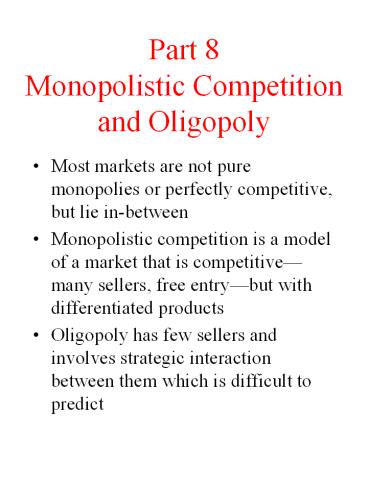Part 8 Monopolistic Competition and Oligopoly - PowerPoint PPT Presentation
1 / 18
Title:
Part 8 Monopolistic Competition and Oligopoly
Description:
Equilibrium of a game ... If one cheats and the other sticks with the agreement, the cheater makes large ... Can overcome the prisoners' dilemma in a repeated game ... – PowerPoint PPT presentation
Number of Views:55
Avg rating:3.0/5.0
Title: Part 8 Monopolistic Competition and Oligopoly
1
Part 8Monopolistic Competition and Oligopoly
- Most markets are not pure monopolies or perfectly
competitive, but lie in-between - Monopolistic competition is a model of a market
that is competitivemany sellers, free entrybut
with differentiated products - Oligopoly has few sellers and involves strategic
interaction between them which is difficult to
predict
2
Monopolistic Competition
- Large number of firms
- Each firm produces a differentiated product
- Each firms product is a close but not perfect
substitute for other firms products - Firms compete on product quality, price and
marketing (advertising and packaging) - Firms are free to enter and exit
3
Monopolistic Competition
- Large number of firms means each firm is small
relative to the whole market - One firms actions have negligible effect on
others - No collusion is possible
- Each firms demand curve for its own brand will
be downward sloping but highly elastic - In the long run entry and exit will occur unless
profits are just normal
4
Short Run Equilibrium
P
MC
ATC
P
D
Economic profit
MR
Q
Q
Same as monopoly equilibrium except that The
demand curve will be more elastic
5
Long Run Equilibrium
P
MC
ATC
P
D
MR
Q
Q
Long run equilibrium. New entry occurs
which shifts each firms demand curve in until no
economic profit remains
6
Monopolistic Competition and Efficiency
MC
ATC
P
P
D
MR
Excess capacity
Q
Q
Monopolistic competitionhigher prices, P MC
and excess capacity. Cost of product
differentiation
7
Oligopoly
- Small number of firms in the market
- Barriers to entry
- Interdependencewhat each firm will want to do
will depend on what other firms do - Oligopolists may try to collude
- Collusion may be formal (as in a cartel) or tacit
- Individual firms may have incentives to try to
gain larger market share
8
Duopoly Models
- Two firms
- If they cooperate (collude) the result is the
same as a monopoly and they share monopoly profit - Non-cooperative duopoly
- Bertrand duopoly model
- Each firm sets a price taking the price of the
other firm as given - This leads to price wars
- Zero profit (competitive) equilibrium
9
Duopoly Models
- Cournot duopoly model
- Each firm sets a quantity of output given the
output of the other firm - This leads to an equilibrium with a total output
larger than a monopoly output but less than a
perfectly competitive output
10
Game Theory
- Game theory looks at strategic behaviour
- A Game consists of a set of
- Rules
- Possible strategies
- Payoffs
- Equilibrium of a game
- Nash Equilibrium where each player is doing the
best he can given what the other player is doing - Dominant Strategy Equilibrium where each player
has a unique best strategy regardless of what the
other player does
11
Prisoners Dilemma Game
A
dont confess
confess
-5
-2
dont confess
-20
-5
B
-20
-15
confess
-2
-15
The prisoners cannot communicate. Given these
payoffs each person will confess even although
they would be better off if they both denied.
Confess is a dominant strategy.
12
Application to a Cartel
- A cartel is a group of firms who enter into a
collusive agreement to raise prices - Each firm has a choice of sticking with the
collusive agreement or cheating on the agreement
by producing extra to increase its own profit - Strategies to collude or to cheat
13
Cartels
- If both firms collude they behave like a
monopolist and share the monopoly profit - If both cheat the market becomes competitive and
they both earn normal profit - If one cheats and the other sticks with the
agreement, the cheater makes large profits and
the colluder makes a loss
14
Duopoly Payoff Matrix
Firm A
Cheat
Comply
-1
0
Cheat
4.5
0
Firm B
4.5
2
Comply
2
-1
Dominant strategy is for each firm to cheat,
despite the fact that both would be better off
if they colluded.
15
Repeated Games
- Can overcome the prisoners dilemma in a repeated
game - This allows for strategies that elicit
cooperation - Tit for tat strategy
- Result will be a collusive equilibrium that has
been arrived at tacitly
16
Kinked Demand Curve Model
- Based on an assumption concerning the firms
beliefs about what other firms will do in
response to its own price changes - If it raises its priceothers will not follow
- If it lowers its price others will follow
- Demand is elastic above the current price and
inelastic below - Demand curve is kinked at the current priceMR is
discontinuous below the kink
17
Kinked Demand Curve
P
MC
MC
P
D
MR
Q
Q
Firms price and quantity will not change as long
as MC lies between MC and MC
18
Some other Oligopoly Games
- Product differentiation
- Competitive advertising
- Other forms of non-price competition
- Price leadershiplargest firm sets the price and
other firms follow - Oligopolies and restrictive trade practices
- Rent seeking activity
















![Economics, 6th, Parkin, 2004, Chapter 9: ???? [?1?] PowerPoint PPT Presentation](https://s3.amazonaws.com/images.powershow.com/7338318.th0.jpg?_=201511040311)














